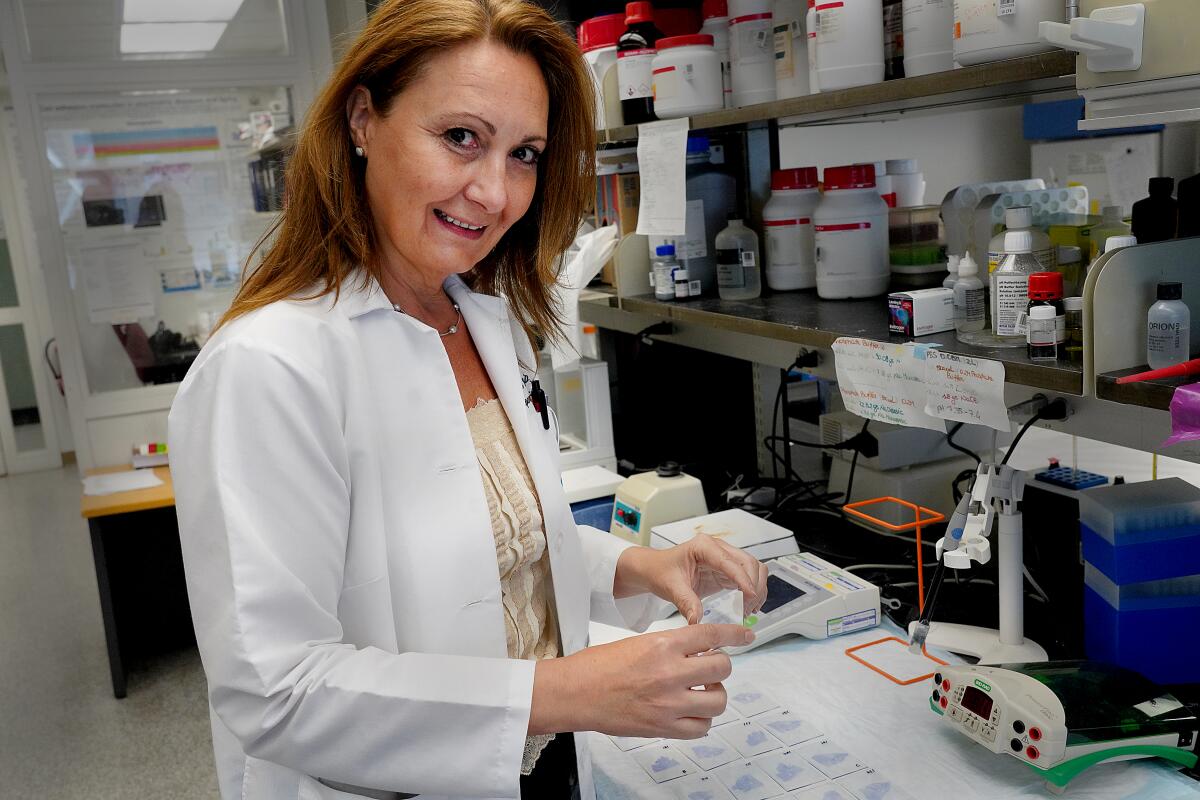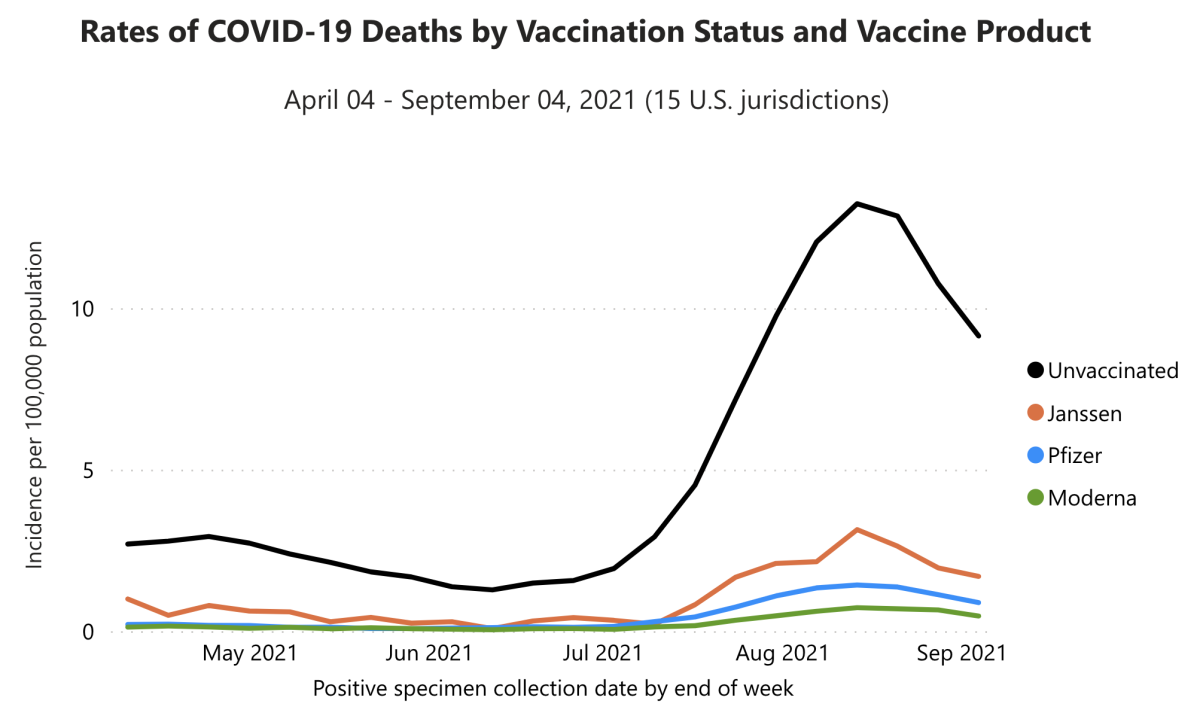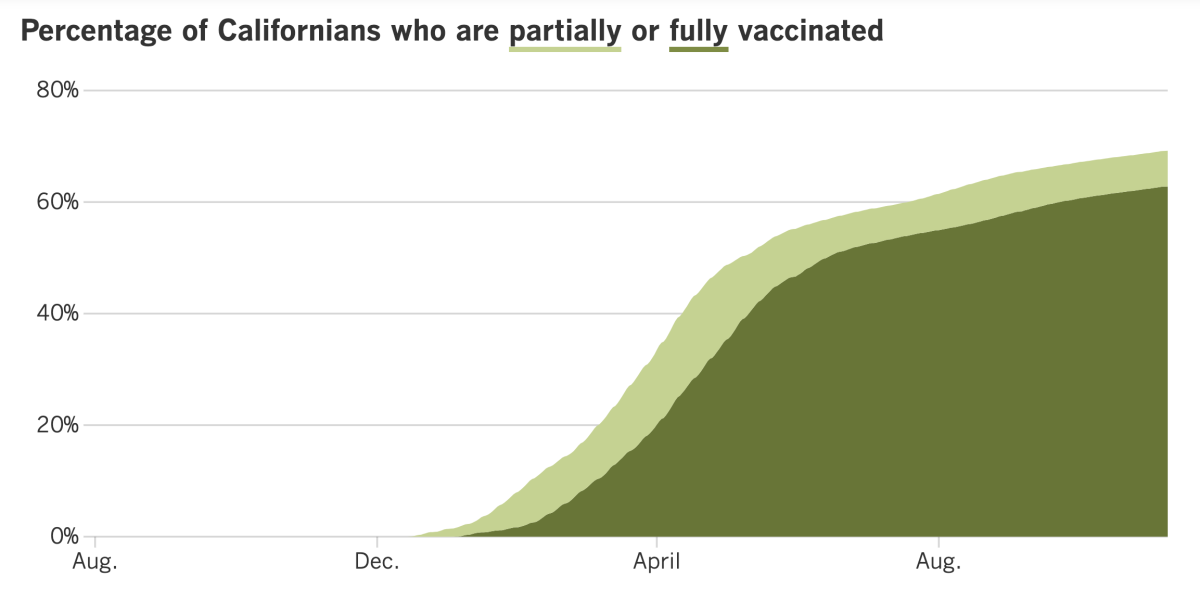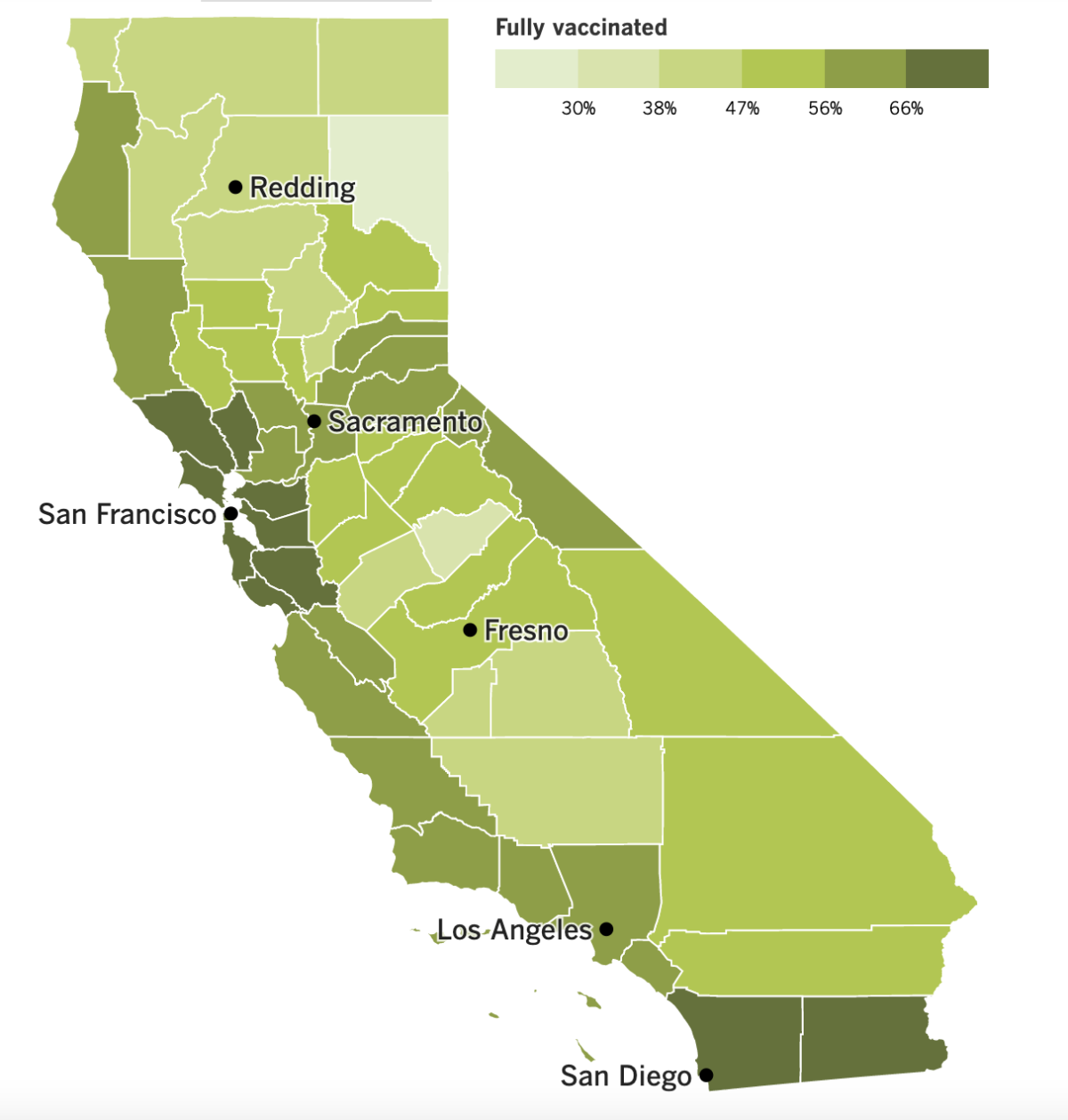Coronavirus Today: What COVID-19 may reveal about mental illness
Good evening. I’m Karen Kaplan, and it’s Tuesday, Nov. 9. Here’s the latest on what’s happening with the coronavirus in California and beyond.
Dr. Maura Boldrini is a neuroscientist and psychiatrist at Columbia University. So when COVID-19 laid siege to New York City in the early days of the pandemic, she was uniquely situated to notice that the respiratory disease also produced a surprising number of symptoms related to the brain.
Memory lapses. Fatigue. Brain fog. Paranoia. Hallucinations. Psychosis.
These kinds of mood and psychiatric symptoms typically arise during adolescence or early adulthood, but the COVID-19 patients who developed them were significantly older. In another twist, there was nothing in their family histories that would suggest they’d be vulnerable to these types of problems.
To Boldrini and others, these clues suggest COVID-19 is able to mount a direct attack on the brain. But as far as researchers can tell, the coronavirus isn’t able to penetrate any farther than the brain’s periphery.
Boldrini is investigating the possibility that these mysterious symptoms are the collateral damage of inflammation, the immune system’s all-hands-on-deck response to an invader. Inflammation is known to trigger blood clots, and clots trigger more inflammation. It’s similar to what happens to victims of traumatic brain injuries.
“People that have this kind of trauma in the brain have presented with sudden changes in behavior and personality and suicide and other brain symptoms,” she told my colleague Amina Khan.

To learn more, Boldrini has gathered the brains of more than 40 COVID-19 victims. Her lab at the New York State Psychiatric Institute contains dozens of boxes that hold paper-thin slices of brain tissue.
Through the painstaking tasks of counting cells, observing their connections with one another, tracking gene expression and documenting proteins, Boldrini’s army of scientists is attempting to re-create a crime scene of sorts. If they succeed, their discoveries may help protect the brains of future COVID-19 patients — and shed light on the origins of dementia and mental illness more broadly.
“I think this could be very useful to fight the stigma against psychiatric illness,” Boldrini said. “The brain is an organ, like any other one.”
By the numbers
California cases and deaths as of 4:28 p.m. Tuesday:

Track California’s coronavirus spread and vaccination efforts — including the latest numbers and how they break down — with our graphics.
COVID-19 vaccines don’t kill, but misinformation can be deadly
“Vaccines Kill.” “COVID Vaccines Are Toxic.”
So read some of the signs brandished by protesters who gathered near Los Angeles City Hall on Monday to vent their anger over the city’s strict vaccine mandates. (To recap, the city now requires proof of full vaccination to enter an array of businesses, and city workers have until Dec. 18 to show that they’re vaccinated or else get a medical or religious exemption.)
Some of the thousands of people who attended the protest seemed sincere when they said they were nervous about the safety of the shots, even though more than 433 million doses have been administered to more than 224 million Americans, according to the Centers for Disease Control and Prevention. With two-thirds of all U.S. residents now at least partially vaccinated, any rash of serious side effects would be impossible to cover up.
Still, Michael McMahon said his doubts about the “still-experimental” injection were greater than his devotion to his job with the L.A. Police Department. The 14-year veteran turned in his badge and gun Friday because he refused to get a COVID-19 vaccination (not even the one made by Pfizer and BioNTech, which has received full approval from the Food and Drug Administration).
It was “one of the hardest days of my life,” McMahon told the crowd.
Others attended the protest because they opposed vaccine mandates on principle. That sentiment was captured in a handmade sign held by Cindy Lazo: “I’m not anti Vaxx. I’m anti Mandates.”
But another contingent was motivated by partisanship. Signs and T-shirts proclaimed “Let’s Go Brandon,” a phrase used by some Republicans to insult President Biden. Hats touted the extremist Proud Boys. At least one sign endorsed the Jan. 6 attack on the U.S. Capitol, and one of the speakers was Dr. Simone Gold, an insurrection participant and founder of a group that spreads misinformation about COVID-19. (Gold is awaiting trial on federal charges of violent entry and disorderly conduct for her role in the attack.)
“This is actually their goal,” Gold said of the officials who adopted vaccine mandates, “to create a world where humans believe that they need overlords to think for them.”
Actually, their goal is to save lives. More than 753,000 Americans have died of COVID-19 — and more than half of those deaths have occurred since the first COVID-19 vaccine was authorized for use in the U.S.
Take a look at this graph, which comes from the CDC:

It shows the COVID-19 death rate for people who have received each of the three COVID-19 vaccines available in the U.S. and for those who are unvaccinated. (The underlying data were provided by 15 health departments that serve nearly 30% of the U.S. population.)
Between Aug. 29 and Sept. 4 — the most recent week available — there were 0.47 COVID-19 deaths for every 100,000 people who were fully vaccinated with the Moderna shots, 0.88 COVID-19 deaths for every 100,000 people fully immunized with the Pfizer shots, and 1.7 deaths for every 100,000 people fully immunized with the Johnson & Johnson shot.
If you combine everyone who was fully vaccinated into one group, the COVID-19 mortality rate was 0.74 deaths per 100,000 people. During the same week, there were 9.14 COVID-19 deaths for every 100,000 people who were unvaccinated.
Which group of people would you rather be in — the one with the 0.0007% chance of dying of COVID-19, or the one whose risk was more than 12 times higher?
The pattern is the same for California:
During the seven-day period ending Oct. 31, there were an average of 0.016 COVID-19 deaths for every 100,000 fully vaccinated Californians ages 16 and up, compared with 0.32 deaths for every 100,000 unvaccinated Californians in that age group. That means those who remained unvaccinated were 20 times more likely to die of COVID-19.
Both graphs make one thing crystal clear: At all times since the vaccines became available, people who were fully vaccinated were less likely to die of COVID-19 than people who were unvaccinated.
California’s vaccination progress


See the latest on California’s vaccination progress with our tracker.
Your support helps us deliver the news that matters most.
In other news ...
Just a couple of weeks ago, it looked like coronavirus cases were stabilizing in the Golden State.
Well, that didn’t last long.
The latest data from around California show that hospitalizations have risen significantly in places with low vaccination rates, reviving fears of a bigger surge once the holiday season gets underway. Hospitalizations in Riverside, San Bernardino and Fresno counties have climbed more than 20% in recent weeks.
In Fresno County, “the bigger hospitals are probably between 110% to 130% of normal capacity,” said Dan Lynch, director of the Central California Emergency Medical Services Agency. “We’re seeing the hospital emergency departments overwhelmed.”
In some parts of the state, even relatively high vaccination rates haven’t been enough to keep hospitalizations from rising. In Orange County, for example, the number of inpatients with COVID-19 has climbed 16% since Halloween. That might be explained by the fact that people’s vaccine protection is waning.
So far, plenty of Californians haven’t felt an urgent need to get booster shots. For instance, although boosters are recommended for all seniors, less than one-third of state residents 65 and older have gotten the extra dose so far.
“Keep your immunity up,” Gov. Gavin Newsom tweeted Tuesday morning. “Get your booster.”
Newsom isn’t the only one saying that. So are the NBA and the National Basketball Players Assn.
The two groups have advised players, coaches and referees to get booster shots if they received the Johnson & Johnson vaccine more than two months ago or either the Pfizer-BioNTech or Moderna vaccine at least six months ago.
The league has been keeping a close eye on the vaccines’ effectiveness, noting that a small number of players have experienced breakthrough infections. An estimated 97% of players were vaccinated when the new season started last month — a rate far above the 80.8% for U.S. adults as a whole.
To encourage the uptake of boosters, the league and players’ association said those who didn’t get the extra shots when they’re eligible for them would have to take coronavirus tests on game days, starting Dec. 1.
Pfizer is doing its part to push for boosters. The company asked the FDA to extend its authorization of booster shots to everyone 18 and older.
An FDA scientific advisory panel recommended against making boosters so broadly available less than two months ago. But since then, several studies have demonstrated that the shots’ protection is wearing off.
And Pfizer piled on by sharing early results from its own study of 10,000 people, which showed that a third dose restored protection against COVID-19 to nearly 96%, even as the Delta variant was surging. Five of the trial participants who received a real booster shot came down with COVID-19 a week or more later, compared with 109 trial participants who got a placebo, the company said.
Now for some good news: The U.S. fully reopened its borders with Mexico and Canada on Monday for the first time in more than a year and a half.
In Tijuana, hundreds of cars lined up before the clock struck midnight and the new travel policy took effect, allowing non-citizens to enter the U.S. for nonessential reasons as long as they were fully vaccinated. (Check out today’s reader question below for more detail on the changes.) Cars were also backed up for miles in Mexicali and Nogales.
Octavio Alvarez and his 14-year-old daughter Sofia entered the U.S. for the first time since February 2020. They planned to visit Alvarez’s mother-in-law for the first time in two years.
“It’s a big feeling,” said Alvarez, who used to visit twice a month before the pandemic hit. The emotional cost of the border restrictions were “very high,” he added.
At the northern border, Canadian River Robinson couldn’t wait to introduce her American partner to their 17-month-old son. It’s “crazy to think he has a whole other side of the family he hasn’t even met yet,” Robinson said.
Emotional reunions took place in airports too as restrictions affecting most European countries were lifted.
The welcome mat was rolled out to those who had received a COVID-19 vaccine blessed by the World Health Organization. That list does not include China’s CanSino vaccine or Russia’s Sputnik V shot, and people who had received them have been scrambling to find replacements.
One of them was Budapest resident Akos Sipos, who didn’t hesitate to get two doses of Sputnik V this spring.
“I thought it’s better to get Sputnik today than a Western vaccine at some uncertain future time,” he said. “But I couldn’t have known at that time that I wouldn’t be able to travel with Sputnik.”
Now he has been re-vaccinated with Moderna’s vaccine.
Your questions answered
Today’s question comes from readers who want to know: What are the new rules about international travel?
The short answer is, instead of restricting entry into the U.S. based on where visitors live, it’s now based on whether visitors are vaccinated against COVID-19.
As of Monday, adult citizens of other countries can come here as long as they show proof that they’re fully vaccinated with one of the shots the World Health Organization has authorized for emergency use. In addition to the three vaccines being administered here, the list includes shots made by AstraZeneca, Covaxin, Covishield, Sinopharm and Sinovac.
That’s the only requirement for travelers coming into the U.S. by car or ferry. Foreign citizens arriving by air also have to show that they’ve tested negative for a coronavirus infection in the 72 hours before their flight departs.
It is possible for unvaccinated visitors to enter the country, but they’ll need to get special permission from the U.S. government. Tourism or business trips won’t cut it — they’ll have to show there is some kind of humanitarian or emergency reason why they need to come to the United States. (Receiving specialized, time-sensitive medical care is one example.) But this option is limited to those who live in one of roughly 50 countries where vaccines are so scarce that fewer than 10% of people there have been vaccinated.
The vaccination requirement only applies to adults. Children and teens ages 3 to 17 are welcome here if they have a negative coronavirus test. Infants and toddlers 2 and younger do not need to get tested.
American citizens returning from abroad face similar rules. Those who are fully vaccinated will need to produce a negative coronavirus test within 72 hours of their flight’s departure. U.S. citizens who are not vaccinated may return home by air, but they’ll need to test negative for a coronavirus infection within 24 hours of departure.
We want to hear from you. Email us your coronavirus questions, and we’ll do our best to answer them. Wondering if your question’s already been answered? Check out our archive here.
Resources
Need a vaccine? Keep in mind that supplies are limited, and getting one can be a challenge. Sign up for email updates, check your eligibility and, if you’re eligible, make an appointment where you live: City of Los Angeles | Los Angeles County | Kern County | Orange County | Riverside County | San Bernardino County | San Diego County | San Luis Obispo County | Santa Barbara County | Ventura County
Practice social distancing using these tips, and wear a mask or two.
Watch for symptoms such as fever, cough, shortness of breath, chills, shaking with chills, muscle pain, headache, sore throat and loss of taste or smell. Here’s what to look for and when.
Need to get tested? Here’s where you can in L.A. County and around California.
Americans are hurting in many ways. We have advice for helping kids cope, resources for people experiencing domestic abuse and a newsletter to help you make ends meet.
We’ve answered hundreds of readers’ questions. Explore them in our archive here.
For our most up-to-date coverage, visit our homepage and our Health section, get our breaking news alerts, and follow us on Twitter and Instagram.




